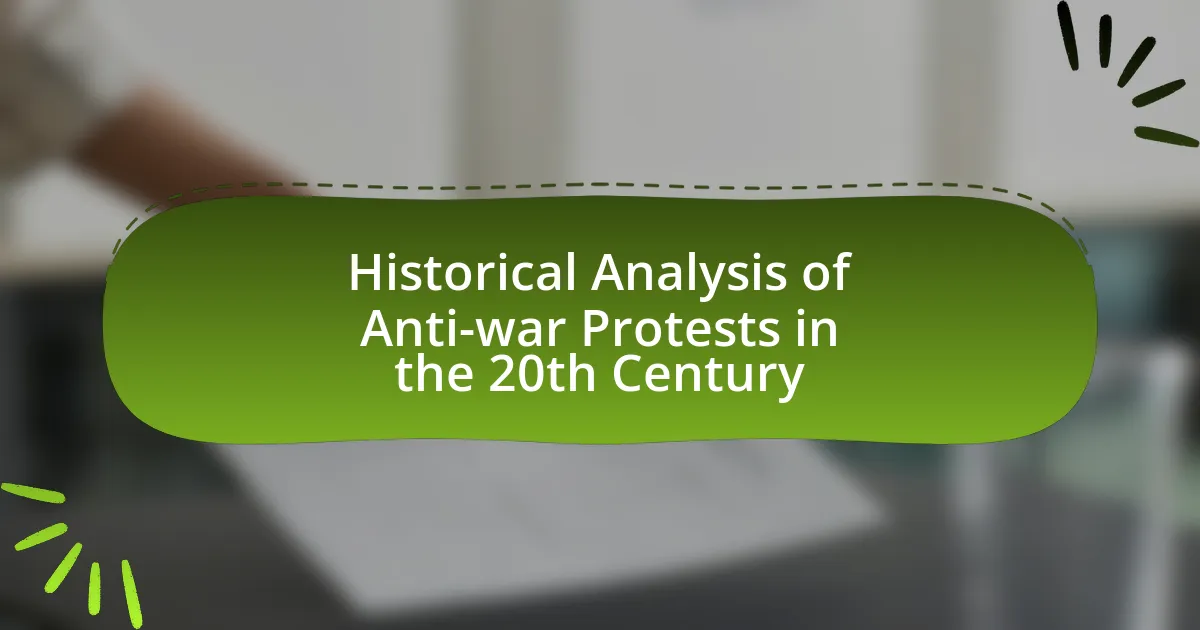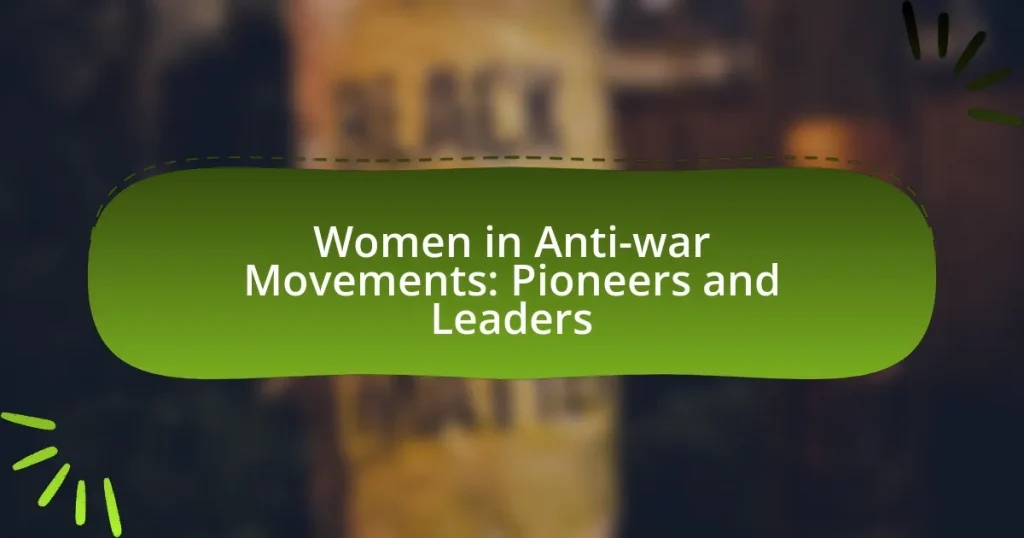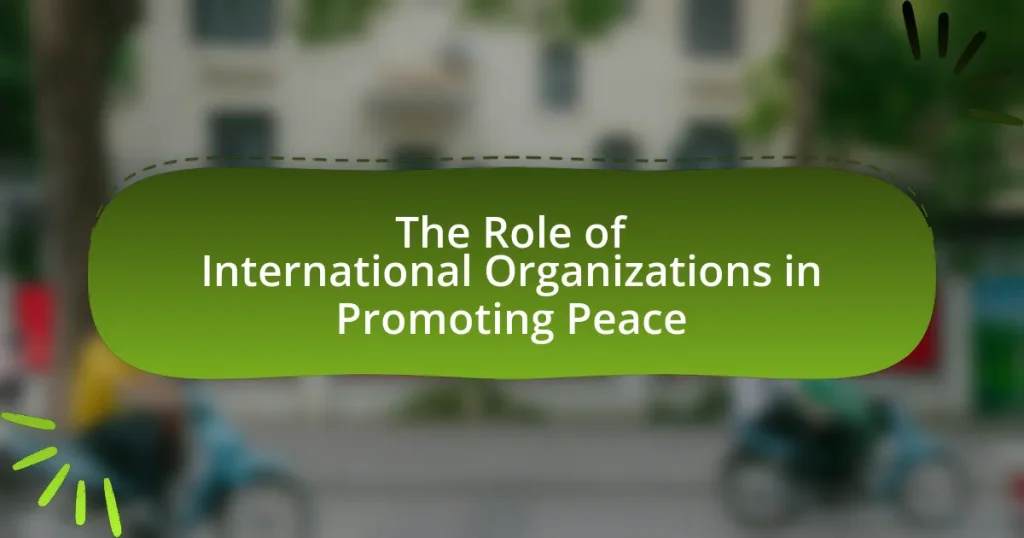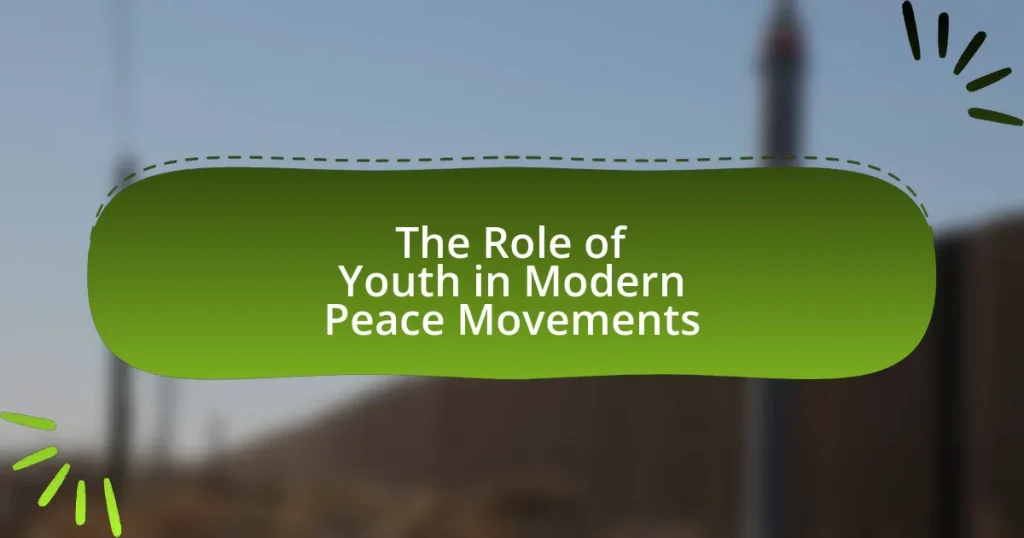The article provides a historical analysis of anti-war protests in the 20th century, focusing on key events such as the Vietnam War, the Cold War, and the Gulf War. It examines how World War I influenced anti-war sentiments and highlights specific events that sparked protests, including the Kent State shootings and the sinking of the RMS Lusitania. The article discusses the role of grassroots organizing, coalition-building, and the impact of media and art in shaping public perception and mobilizing activism. Additionally, it analyzes the outcomes of these protests, including shifts in public opinion, legislative changes, and their lasting effects on future social justice movements.
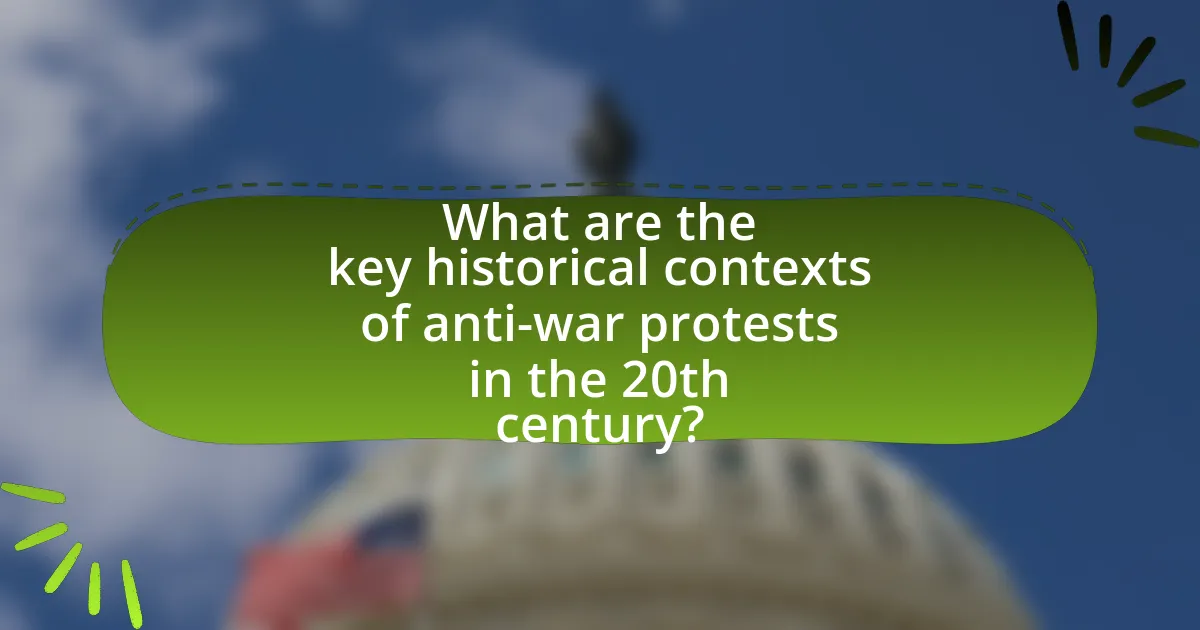
What are the key historical contexts of anti-war protests in the 20th century?
The key historical contexts of anti-war protests in the 20th century include the Vietnam War, the Cold War, and the Gulf War. The Vietnam War, particularly in the 1960s and early 1970s, sparked widespread protests in the United States and globally, driven by opposition to U.S. military involvement and the moral implications of the conflict, exemplified by events such as the Kent State shootings in 1970. The Cold War era also saw significant anti-war movements, particularly against nuclear weapons and military interventions, as exemplified by the protests against the U.S. invasion of Grenada in 1983. Additionally, the Gulf War in the early 1990s prompted protests against military action in Iraq, highlighting concerns over civilian casualties and the motives behind U.S. foreign policy. These contexts illustrate how geopolitical events and public sentiment shaped the landscape of anti-war activism throughout the century.
How did World War I influence anti-war sentiments?
World War I significantly influenced anti-war sentiments by exposing the brutal realities of modern warfare and its devastating consequences on soldiers and civilians alike. The extensive loss of life, with an estimated 16 million deaths and 21 million wounded, led to widespread disillusionment with military conflict. This disillusionment was further fueled by the propaganda that initially glorified the war, which contrasted sharply with the grim experiences of trench warfare and chemical attacks. The war’s aftermath saw the rise of pacifist movements and organizations, such as the American Union Against Militarism, which advocated for peace and highlighted the futility of war. Additionally, literature and art from the period, including works by authors like Erich Maria Remarque in “All Quiet on the Western Front,” vividly depicted the horrors of war, reinforcing anti-war sentiments among the public.
What specific events sparked protests during World War I?
The specific events that sparked protests during World War I include the sinking of the RMS Lusitania in 1915, which resulted in the deaths of 1,198 passengers, including 128 Americans, leading to anti-war sentiments in the United States. Additionally, the introduction of conscription in various countries, particularly in Britain and the United States, fueled public outrage against mandatory military service. The Bolshevik Revolution in 1917 also inspired protests, as it highlighted the war’s devastating impact on soldiers and civilians alike, prompting calls for peace and an end to the conflict. These events collectively galvanized public opinion against the war, leading to widespread demonstrations and organized movements advocating for peace.
How did the aftermath of World War I shape future anti-war movements?
The aftermath of World War I significantly shaped future anti-war movements by fostering widespread disillusionment with militarism and highlighting the devastating consequences of war. The war’s unprecedented loss of life, with an estimated 16 million deaths, led to a collective trauma that galvanized public sentiment against future conflicts. This disillusionment was further amplified by the Treaty of Versailles, which many viewed as punitive and unjust, creating a fertile ground for pacifist ideologies to take root.
Organizations such as the American Civil Liberties Union, founded in 1920, emerged in this context, advocating for civil rights and opposing militaristic policies. The interwar period also saw the rise of influential figures like Bertrand Russell and the establishment of the War Resisters’ International in 1921, both of which promoted anti-war philosophies and activism. These developments laid the groundwork for future movements, including the anti-Vietnam War protests of the 1960s, demonstrating a sustained legacy of opposition to war that originated in the disillusionment following World War I.
What role did the Vietnam War play in the rise of anti-war protests?
The Vietnam War significantly fueled the rise of anti-war protests in the United States during the 1960s and early 1970s. As the conflict escalated, public discontent grew due to the high casualty rates, the draft, and the perception of U.S. involvement as unjust. By 1969, over 500,000 American troops were deployed in Vietnam, leading to widespread opposition, particularly among students and civil rights activists. Events such as the Kent State shootings in 1970, where four students were killed during a protest, galvanized national outrage and further mobilized anti-war sentiment. This period saw the formation of influential organizations like Students for a Democratic Society and the Vietnam Veterans Against the War, which organized large-scale demonstrations, highlighting the war’s moral and ethical implications. The cumulative effect of these protests played a crucial role in shaping public opinion and ultimately contributed to the U.S. withdrawal from Vietnam in 1973.
What were the major protests against the Vietnam War?
The major protests against the Vietnam War included the 1965 anti-war march in Washington, D.C., the 1967 March on the Pentagon, and the Kent State University protests in 1970. The 1965 march marked one of the first large-scale demonstrations against U.S. involvement in Vietnam, drawing over 20,000 participants. The 1967 March on the Pentagon involved thousands of activists who attempted to levitate the building as a symbolic act of protest. The Kent State protests were particularly significant as they culminated in the tragic shooting of four students by the National Guard, which intensified public outrage and opposition to the war. These events collectively highlighted the growing dissent against U.S. military actions in Vietnam and mobilized a broader anti-war movement across the country.
How did media coverage affect public perception of the Vietnam War protests?
Media coverage significantly shaped public perception of the Vietnam War protests by bringing the events into the living rooms of Americans, influencing their views on the war and the protesters. The extensive broadcasting of protest images, such as the Kent State shootings in 1970, highlighted the violent clashes between demonstrators and law enforcement, which swayed public opinion against the war. According to a Gallup poll conducted in 1971, support for the Vietnam War dropped to 28% as media coverage revealed the stark realities of the conflict and the dissent surrounding it. This shift in perception was further fueled by televised reports that showcased the growing anti-war sentiment, leading to increased public empathy for the protesters and a questioning of government narratives.
How did the Cold War era impact anti-war activism?
The Cold War era significantly intensified anti-war activism, particularly in response to U.S. military involvement in conflicts such as the Vietnam War. Activists mobilized against perceived imperialism and the threat of nuclear war, leading to widespread protests, notably the 1969 Moratorium to End the War in Vietnam, which drew millions of participants. The anti-war movement gained momentum through grassroots organizations, college campuses, and influential figures like Martin Luther King Jr., who condemned the war as a moral issue. This period also saw the establishment of various coalitions, such as the Students for a Democratic Society, which advocated for peace and social justice, reflecting a broader discontent with government policies. The impact of the Cold War on anti-war activism is evidenced by the substantial public demonstrations and the eventual shift in U.S. policy, culminating in the withdrawal from Vietnam in 1973.
What were the key anti-war organizations formed during the Cold War?
The key anti-war organizations formed during the Cold War included the Students for a Democratic Society (SDS), the Vietnam Veterans Against the War (VVAW), and the American Friends Service Committee (AFSC). The SDS, established in 1960, played a significant role in mobilizing college students against the Vietnam War, advocating for civil rights and social justice. The VVAW, founded in 1967, consisted of veterans who publicly opposed the war, highlighting the moral and psychological toll of combat. The AFSC, a Quaker organization, actively promoted peace and disarmament throughout the Cold War, emphasizing nonviolent solutions to conflict. These organizations collectively influenced public opinion and policy regarding military engagement during this period.
How did the threat of nuclear war influence anti-war protests?
The threat of nuclear war significantly intensified anti-war protests during the Cold War era. As the possibility of nuclear conflict loomed, public fear and anxiety about the catastrophic consequences of such a war galvanized individuals and groups to mobilize against military actions, particularly in Vietnam. For instance, the 1960s saw massive demonstrations, such as the March on the Pentagon in 1967, where protesters highlighted the dangers of nuclear escalation and called for disarmament. This connection between nuclear threat and anti-war sentiment was further underscored by events like the Cuban Missile Crisis in 1962, which heightened awareness of the immediate risks associated with military confrontations. The pervasive fear of annihilation led to a broader anti-nuclear movement, intertwining with anti-war activism and fostering a culture of dissent against government policies perceived as reckless.
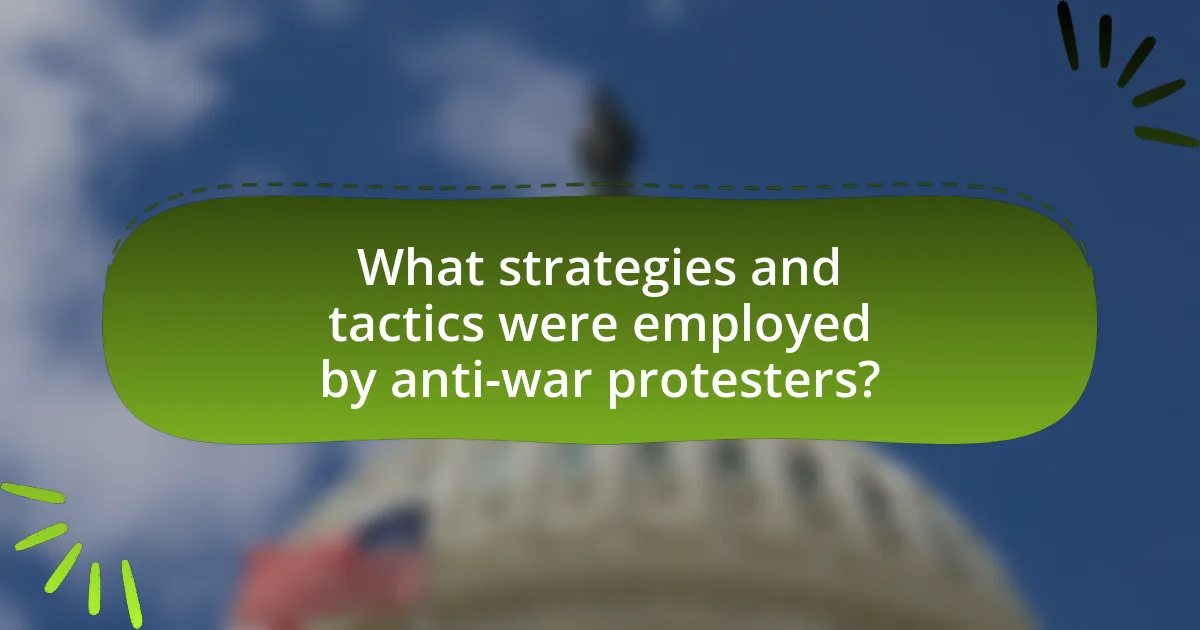
What strategies and tactics were employed by anti-war protesters?
Anti-war protesters employed a variety of strategies and tactics, including mass demonstrations, civil disobedience, and grassroots organizing. Mass demonstrations, such as the 1969 Moratorium to End the War in Vietnam, mobilized hundreds of thousands of participants, effectively raising public awareness and pressure on policymakers. Civil disobedience, exemplified by sit-ins and protests at military recruitment centers, aimed to disrupt normal operations and draw attention to the anti-war cause. Grassroots organizing involved building local coalitions and networks to foster community engagement and support for anti-war initiatives, as seen in the efforts of organizations like Students for a Democratic Society. These tactics collectively contributed to shaping public opinion and influencing government decisions regarding military involvement.
How did grassroots organizing shape the anti-war movement?
Grassroots organizing significantly shaped the anti-war movement by mobilizing local communities to advocate against military conflicts, particularly during the Vietnam War era. This grassroots approach enabled individuals to connect their personal experiences and concerns with broader political issues, fostering a sense of collective action. For instance, organizations like Students for a Democratic Society (SDS) and the Vietnam Veterans Against the War (VVAW) utilized grassroots strategies to organize protests, rallies, and educational campaigns, effectively raising public awareness and influencing public opinion. The widespread participation in local demonstrations and the establishment of networks across various demographics demonstrated the power of grassroots efforts in challenging government policies and promoting peace.
What methods were used to mobilize supporters for protests?
Methods used to mobilize supporters for protests included grassroots organizing, social media campaigns, and coalition-building among various activist groups. Grassroots organizing involved local community meetings and outreach efforts to engage individuals directly affected by war policies. Social media campaigns leveraged platforms like Facebook and Twitter to disseminate information rapidly, coordinate events, and create viral content that raised awareness. Coalition-building brought together diverse organizations, such as labor unions, student groups, and civil rights organizations, to amplify their collective voice and resources, as seen in the Vietnam War protests where groups like the Students for a Democratic Society collaborated with established anti-war organizations. These methods were effective in creating a broad base of support and mobilizing large numbers of participants for protests.
How did coalition-building enhance the effectiveness of anti-war protests?
Coalition-building significantly enhanced the effectiveness of anti-war protests by uniting diverse groups with shared goals, thereby amplifying their collective voice and impact. For instance, during the Vietnam War, organizations such as the Students for a Democratic Society and the American Civil Liberties Union collaborated with various civil rights groups, which increased participation and visibility. This unity allowed for larger demonstrations, such as the 1969 Moratorium to End the War in Vietnam, which drew millions of participants nationwide, showcasing widespread opposition to the war. The collaboration also facilitated resource sharing, strategic planning, and broader media coverage, ultimately leading to greater public awareness and pressure on policymakers to reconsider military actions.
What role did art and culture play in anti-war protests?
Art and culture played a significant role in anti-war protests by serving as powerful tools for expression and mobilization. Artistic mediums such as music, visual art, literature, and theater conveyed anti-war sentiments, raised awareness, and fostered community among activists. For instance, the Vietnam War era saw the emergence of protest songs like “Fortunate Son” by Creedence Clearwater Revival, which criticized social inequalities and the draft system, galvanizing public sentiment against the war. Additionally, visual art, such as the iconic “Peace” symbol and protest posters, visually communicated dissent and solidarity, making the anti-war message accessible and relatable. Cultural events, including festivals and performances, created spaces for collective action and dialogue, further amplifying the anti-war movement’s reach and impact.
How did music influence the anti-war movement?
Music significantly influenced the anti-war movement by serving as a powerful medium for expression and mobilization. Songs like “Give Peace a Chance” by John Lennon and “Fortunate Son” by Creedence Clearwater Revival became anthems that articulated the sentiments of dissent against the Vietnam War, resonating with a wide audience and fostering a sense of solidarity among protesters. The use of music in rallies and demonstrations helped to unify diverse groups, making the anti-war message more accessible and emotionally impactful. Additionally, music festivals, such as Woodstock in 1969, provided a platform for artists to voice their opposition to war, further amplifying the movement’s reach and cultural significance.
What impact did visual art and literature have on public awareness?
Visual art and literature significantly enhanced public awareness of anti-war sentiments during the 20th century. Through powerful imagery and evocative narratives, artists and writers conveyed the emotional and social consequences of war, influencing public perception and mobilizing activism. For instance, works like Picasso’s “Guernica” and Erich Maria Remarque’s “All Quiet on the Western Front” starkly depicted the horrors of conflict, leading to increased public discourse and opposition to war policies. These artistic expressions served as catalysts for social movements, as they resonated with audiences and fostered a collective consciousness against militarism.
How did technology affect the organization of anti-war protests?
Technology significantly enhanced the organization of anti-war protests by facilitating communication and coordination among activists. The advent of the internet and social media platforms allowed for rapid dissemination of information, enabling organizers to mobilize large groups quickly. For instance, during the Vietnam War, platforms like Facebook and Twitter were instrumental in spreading awareness and rallying support, leading to massive protests such as the 1969 Moratorium to End the War in Vietnam, which drew hundreds of thousands of participants. Additionally, the use of mobile phones allowed for real-time updates and coordination on the ground, making protests more dynamic and responsive to changing circumstances. This technological integration fundamentally transformed the landscape of activism, making it more accessible and effective.
What role did print media play in spreading anti-war messages?
Print media played a crucial role in spreading anti-war messages by providing a platform for dissenting voices and facilitating the dissemination of information critical of war policies. Newspapers, magazines, and pamphlets published articles, editorials, and illustrations that highlighted the human costs of war, questioned government narratives, and mobilized public opinion against military actions. For instance, during the Vietnam War, publications like “The New York Times” and “The Washington Post” featured investigative reports on the war’s impact, such as the My Lai Massacre, which significantly influenced public perception and fueled anti-war sentiment. Additionally, underground newspapers emerged, offering alternative viewpoints and fostering grassroots activism, thereby amplifying the anti-war movement’s reach and effectiveness.
How has social media transformed modern anti-war activism?
Social media has transformed modern anti-war activism by enabling rapid information dissemination and fostering global connectivity among activists. Platforms like Twitter and Facebook allow for real-time updates on conflicts, mobilizing supporters quickly and efficiently. For instance, during the 2011 Arab Spring, social media played a crucial role in organizing protests against authoritarian regimes, demonstrating its power in facilitating grassroots movements. Additionally, social media campaigns can reach vast audiences, as seen with hashtags like #NoWar and #StopTheWar, which amplify messages and create a sense of community among diverse groups. This shift from traditional media to social media has democratized activism, allowing individuals to participate in anti-war efforts regardless of their geographical location.
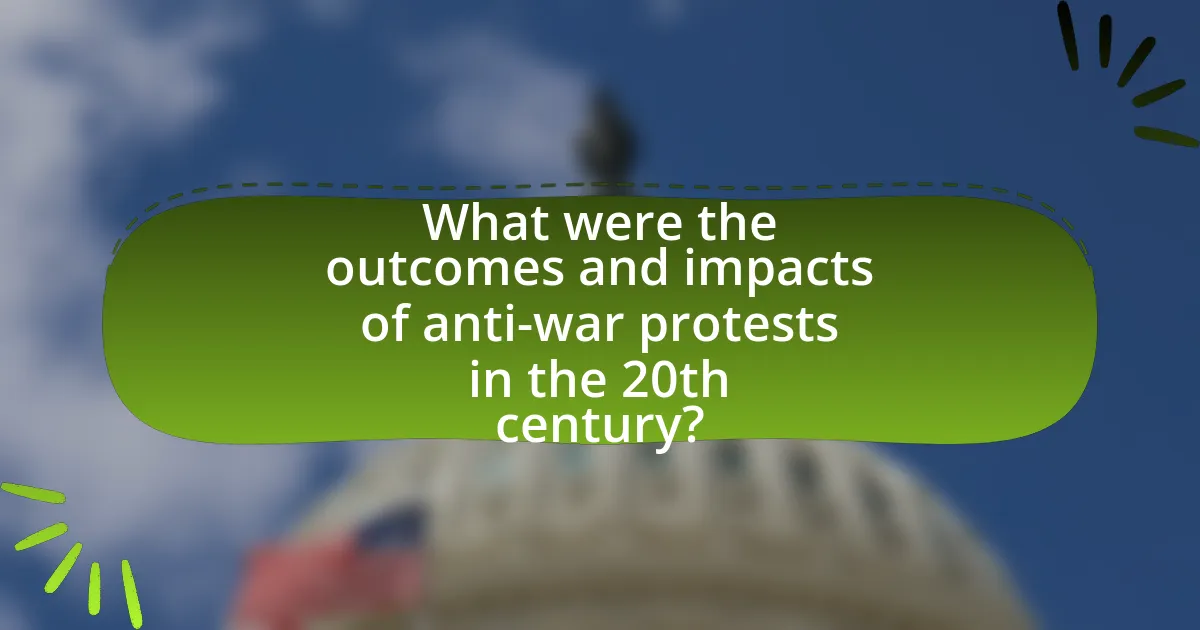
What were the outcomes and impacts of anti-war protests in the 20th century?
Anti-war protests in the 20th century significantly influenced public opinion and policy, particularly regarding military engagements such as the Vietnam War. These protests mobilized millions, leading to increased awareness of the human and economic costs of war, which in turn pressured governments to reconsider their military strategies. For instance, the widespread protests against the Vietnam War in the late 1960s and early 1970s contributed to the eventual withdrawal of U.S. troops in 1973, as evidenced by the 1971 Gallup poll showing that 61% of Americans opposed the war. Additionally, anti-war movements fostered a culture of dissent that encouraged future activism, shaping political discourse around issues of peace, justice, and civil rights throughout the century.
How did anti-war protests influence government policy?
Anti-war protests significantly influenced government policy by creating public pressure that led to changes in military engagement and foreign policy decisions. For instance, the Vietnam War protests in the 1960s and 1970s mobilized millions of Americans, resulting in a shift in public opinion against the war. This widespread dissent prompted the U.S. government to eventually withdraw troops from Vietnam in 1973, as evidenced by the Paris Peace Accords. Additionally, the protests contributed to the establishment of a more cautious approach to military intervention in subsequent conflicts, as policymakers recognized the potential for domestic unrest and political consequences stemming from unpopular wars.
What legislative changes were prompted by anti-war activism?
Legislative changes prompted by anti-war activism include the War Powers Act of 1973, which aimed to limit the President’s ability to engage U.S. forces in hostilities without congressional approval. This act was a direct response to widespread protests against the Vietnam War, reflecting public demand for greater oversight of military actions. Additionally, anti-war activism influenced the repeal of the Gulf of Tonkin Resolution in 1970, which had previously granted the President broad military powers in Southeast Asia. These legislative changes demonstrate the significant impact of public dissent on U.S. foreign policy and military engagement.
How did public opinion shift as a result of anti-war protests?
Public opinion shifted significantly against the Vietnam War as a result of anti-war protests. Initially, many Americans supported the war, but as protests grew in size and visibility, particularly during the late 1960s, public sentiment began to change. For instance, a Gallup poll in 1965 showed that 61% of Americans approved of U.S. involvement in Vietnam, but by 1971, that number had dropped to just 28%. The protests highlighted the human cost of the war, leading to increased skepticism about government narratives and a broader anti-establishment sentiment. This shift was further evidenced by the growing number of Americans who identified as anti-war, culminating in significant political consequences, including the eventual withdrawal of U.S. troops in 1973.
What long-term effects did anti-war protests have on society?
Anti-war protests had significant long-term effects on society, including shifts in public opinion, changes in government policy, and the emergence of a more engaged citizenry. These protests, particularly during the Vietnam War era, galvanized widespread opposition to military interventions, leading to a decline in support for such actions and influencing subsequent foreign policy decisions. For instance, the protests contributed to the U.S. government’s eventual withdrawal from Vietnam, as public pressure mounted against continued military involvement. Additionally, the activism surrounding these protests fostered a culture of civic engagement, encouraging individuals to participate in political discourse and advocacy on various social issues, thereby shaping the landscape of American democracy.
How did anti-war movements shape future social justice movements?
Anti-war movements significantly influenced future social justice movements by establishing frameworks for activism, coalition-building, and public discourse. The Vietnam War protests of the 1960s and 1970s, for example, mobilized diverse groups, including civil rights activists, women’s rights advocates, and environmentalists, creating a model for intersectional activism. This coalition-building demonstrated the power of collective action across various social issues, leading to the formation of organizations like the Students for a Democratic Society, which later engaged in broader social justice initiatives. Furthermore, the anti-war movements emphasized the importance of grassroots organizing and nonviolent protest, principles that were adopted by subsequent movements such as the Civil Rights Movement and LGBTQ+ rights campaigns. The legacy of these movements is evident in their ability to galvanize public opinion and influence policy, as seen in the eventual withdrawal of U.S. troops from Vietnam and the subsequent legislative changes addressing civil rights and social equity.
What lessons can be learned from the anti-war protests of the 20th century?
The anti-war protests of the 20th century teach the importance of civic engagement and the power of collective action in influencing government policy. These protests, notably during the Vietnam War, demonstrated that public dissent can lead to significant political change; for instance, widespread protests contributed to the U.S. government’s decision to withdraw troops in 1973. Additionally, the protests highlighted the necessity of critical media coverage and grassroots organization, as seen in the mobilization efforts of groups like Students for a Democratic Society. The effectiveness of these movements underscores the role of activism in shaping public discourse and policy regarding war and peace.
What practical strategies can modern activists learn from historical anti-war protests?
Modern activists can learn the importance of coalition-building and grassroots organizing from historical anti-war protests. For instance, the Vietnam War protests in the 1960s effectively united diverse groups, including students, civil rights activists, and veterans, which amplified their collective voice and impact. This coalition approach demonstrated that a broad base of support can enhance visibility and pressure on policymakers. Additionally, the use of nonviolent direct action, as seen in the protests against the Iraq War in the early 2000s, highlighted the effectiveness of peaceful demonstrations in drawing media attention and public sympathy. Historical data shows that sustained, organized efforts, such as the weekly protests and sit-ins, can maintain momentum and keep issues in the public discourse, ultimately influencing political decisions.
